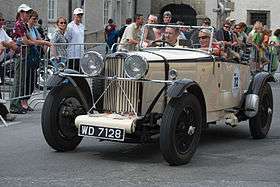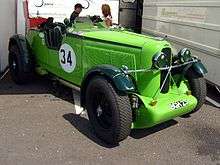Talbot 105
| Talbot 14-45 1926 - 1930 Talbot 18-70 1930 - 1932 Talbot 105 1931 - 1935 | |
|---|---|
 | |
| Overview | |
| Manufacturer | Talbot |
| Production | 1926–1935 |
| Designer | Georges Roesch |
| Body and chassis | |
| Class | sports car |
| Powertrain | |
| Engine | Straight six |
The Talbot 105 was a high powered sports car developed by Talbot designer Georges Roesch. It was famously fast, described by one authority as the fastest four-seater ever to race at Brooklands.[1]
The car made its first appearance at the London Motor Show in 1926.[1] At this stage it was formally named according to its fiscal and actual horsepower as the Talbot 14-45.[1] The six-cylinder engine displaced a volume of 1,666 cc[1] and was the basis for all Talbot engines until the Rootes takeover in 1935.
The engine was repeatedly bored out further, giving rise to a succession of performance improvements. Throughout these developments, the exterior dimensions of the original 14-45 engine block remained the same although the 18-70 had an updated block with equally spaced bores. The later 105 had a different block again.
The 1930 London Motor Show saw the debut of the 18-70 model, bore and stroke both being increased to give an engine capacity increased to 2,276 cc.[1] In this form the car was later called simply the Talbot 70 or 75.[1] Higher compression ratios and a bigger Zenith carburettor resulted in an increase in power and the birth of the 90. Talbot's AO90s were highly successful in GP racing, coming third only to Speed 6 Bentleys in the 1931 Brooklands 500.
An increase in the engine capacity, still without any change to the exterior dimensions of the engine block, yielded a cylinder displacement of 2,969 cc for the iconic Talbot 105 model.[1] In 1931 four 105s were tuned to provide a reported 119 bhp, at 4,800 rpm.[1] In "Brooklands trim" further tuning and in increased compression ratio of 10:1 gave rise to a claimed 125 bhp.[1]

at Silverstone
The Talbot acquired its fame on the racing circuits, featuring prominently at Brooklands on the south-western fringes of London. In 1932 Talbot pulled out of racing, but a major Talbot dealer named Warwick Wright successfully ran a team of three 105s that year, and other teams operated by dealers and enthusiasts continued to race the cars at least till 1938.[1]